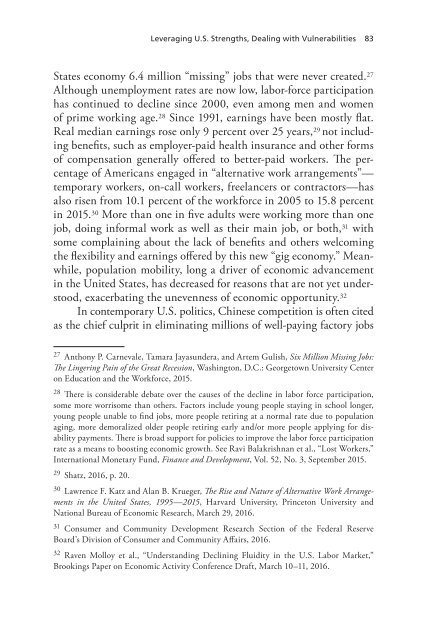You also want an ePaper? Increase the reach of your titles
YUMPU automatically turns print PDFs into web optimized ePapers that Google loves.
Leveraging U.S. Strengths, Dealing with Vulnerabilities 83<br />
States economy 6.4 million “missing” jobs that were never created. 27<br />
Although unemployment rates are now low, labor-force participation<br />
has continued to decline since 2000, even among men and women<br />
of prime working age. 28 Since 1991, earnings have been mostly flat.<br />
Real median earnings rose only 9 percent over 25 years, 29 not including<br />
benefits, such as employer-paid health insurance and other forms<br />
of compensation generally offered to better-paid workers. The percentage<br />
of Americans engaged in “alternative work arrangements”—<br />
temporary workers, on-call workers, freelancers or contractors—has<br />
also risen from 10.1 percent of the workforce in 2005 to 15.8 percent<br />
in 2015. 30 More than one in five adults were working more than one<br />
job, doing informal work as well as their main job, or both, 31 with<br />
some complaining about the lack of benefits and others welcoming<br />
the flexibility and earnings offered by this new “gig economy.” Meanwhile,<br />
population mobility, long a driver of economic advancement<br />
in the United States, has decreased for reasons that are not yet understood,<br />
exacerbating the unevenness of economic opportunity. 32<br />
In contemporary U.S. politics, Chinese competition is often cited<br />
as the chief culprit in eliminating millions of well-paying factory jobs<br />
27 Anthony P. Carnevale, Tamara Jayasundera, and Artem Gulish, Six Million Missing Jobs:<br />
The Lingering Pain of the Great Recession, Washington, D.C.: Georgetown University Center<br />
on Education and the Workforce, 2015.<br />
28 There is considerable debate over the causes of the decline in labor force participation,<br />
some more worrisome than others. Factors include young people staying in school longer,<br />
young people unable to find jobs, more people retiring at a normal rate due to population<br />
aging, more demoralized older people retiring early and/or more people applying for disability<br />
payments. There is broad support for policies to improve the labor force participation<br />
rate as a means to boosting economic growth. See Ravi Balakrishnan et al., “Lost Workers,”<br />
International Monetary Fund, Finance and Development, Vol. 52, No. 3, September 2015.<br />
29 Shatz, 2016, p. 20.<br />
30 Lawrence F. Katz and Alan B. Krueger, The Rise and Nature of Alternative Work Arrangements<br />
in the United States, 1995—2015, Harvard University, Princeton University and<br />
National Bureau of Economic Research, March 29, 2016.<br />
31 Consumer and Community Development Research Section of the Federal Reserve<br />
Board’s Division of Consumer and Community Affairs, 2016.<br />
32 Raven Molloy et al., “Understanding Declining Fluidity in the U.S. Labor Market,”<br />
Brookings Paper on Economic Activity Conference Draft, March 10–11, 2016.




